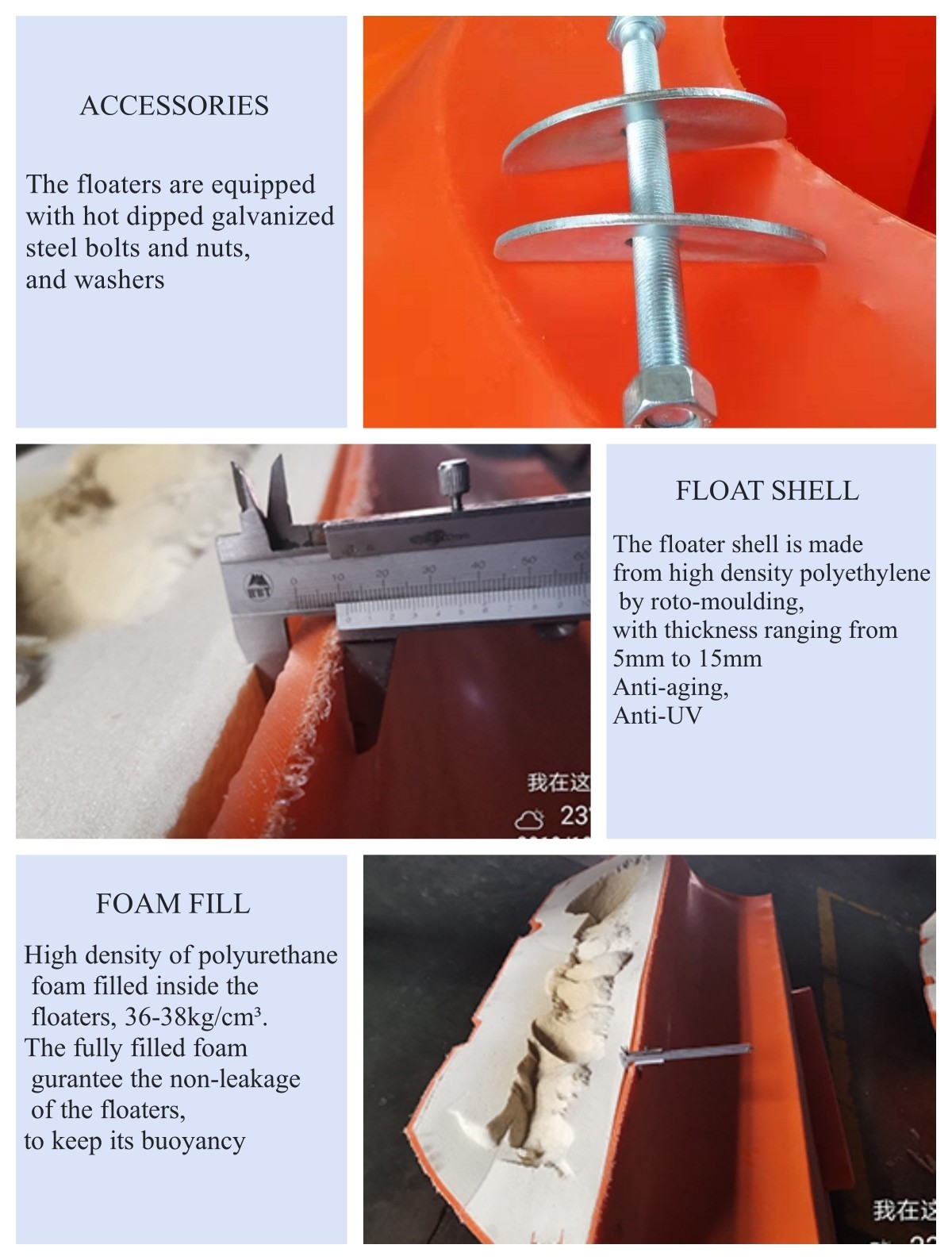PRODUCTS
PRODUCTS
CONTACT US
Dredge pipe floaters are essential components used in dredging operations to keep the dredge pipeline afloat on the water surface. They prevent the pipeline from sinking and provide stability and buoyancy.
Material:
Dredge pipe floaters are typically made from high-density polyethylene (HDPE) material. HDPE is known for its durability, resistance to corrosion, and ability to withstand harsh marine conditions.
Structure:
Dredge pipe floaters are generally designed as cylindrical or rectangular units. They have a hollow structure, with foam or air-filled chambers inside that provide buoyancy. The outer walls of the floaters are thick and sturdy to protect against punctures or damages.The hull of marine dredging floating ring is made from medium density polyethylene material with excellent flexibility, filled with high strength polyurethane foam inside. With reasonable structure and good performance, the float becomes the ideal substitution of the traditional steel floater for the floating dredging pipes.
Connection:
Dredge pipe floaters are connected to the dredge pipeline through a system of bolts, clamps, or brackets. The connection should be secure, ensuring the floaters stay in place even during heavy dredging activities and wave motion.
Advantages:
1. Buoyancy: Dredge pipe floaters provide buoyancy to the dredge pipeline, enabling efficient transportation of dredged materials over long distances.
2. Stability: By keeping the pipeline afloat, the floaters help maintain stability during dredging operations, minimizing disruptions or damage to the dredge pipeline.
3. Easy installation: Dredge pipe floaters are lightweight and easy to install. They can be quickly attached to or detached from the pipeline, making them convenient to transport and relocate.
4. Cost-effective: Floaters reduce the need for extensive dredging support structures, such as pontoons or buoys, which can be costly to install and maintain.
Properties:
1. Flotation capacity: Dredge pipe floaters are designed to provide sufficient buoyancy to support the weight of the dredge pipeline and the materials being transported.
2. Impact resistance: The floaters have excellent impact resistance, protecting the pipeline from collisions with other marine objects or accidental grounding.
3. UV resistance: HDPE material used in the construction of floaters is UV resistant, ensuring prolonged exposure to sunlight does not degrade their structural integrity.
4. Resistance to chemicals and corrosion: Floaters are resistant to chemicals, corrosive substances, and saltwater, making them suitable for use in marine environments.
5. Low maintenance: Dredge pipe floaters require minimal maintenance as they do not rust, corrode, or degrade easily. Regular visual inspections and cleaning are usually sufficient to ensure their performance.
These floaters provide a crucial solution for maintaining the efficiency and safety of dredging operations by ensuring the stable flotation of pipelines, even in demanding marine conditions.

SPEICIFCATIONS OF PE FLOATERS
Tips to Check the Quality of Dredge Pipe Floats:
What inspections should be done before using plastic floats?
Before using pipe floats, a series of checks are required to ensure their safe use. Here are some key inspection steps:
1. Check the appearance of the float: Check the surface of the floats, make sure there are no damage, cracks or any defects that may affect its stability.
2. Check the size of the floating body: Make sure that the size of the floating body is as expected without any deformation or shrinkage. The foaming holes of the floating body must be
welded firmly. If there are leaks, they should be repaired.
3. Check the weight of the floating body: Make sure the weight of the floating body meets the requirements according to the occasion and environment of use. It should not be less than
3%-5% of the order parameters, because the weight of the floating body is related to the weight of the floating body shell and the specific gravity and volume of the floating body foam.
An overweight floating body may affect its buoyancy, while an overly light floating body may Will float in the water instead of supporting the load.
4. Check the stability of the float: Use a heavy object to test the stability of the float to see if it can support the weight and remain on the water.
5. Check the connections: If the float is connected to other equipment or vessels, make sure the connections are tight and don’t show any signs of leakage or breakage.
6. The degree of plasticization of the plastic shell of the floating body. The inside of the plasticized floating body should have a flat and smooth surface without obvious particles.
At this time, the plastic shell has the best tensile strength.
7. Check the buoyancy: Make sure all parts of the float have proper buoyancy distribution to prevent tipping or flipping.
8.Check the weather conditions: Before putting it into use, make sure that the weather conditions are good and there are no wind, waves or other factors that affect the stability of the floating body.
These inspection steps are crucial to ensure the safety and stability of polyethylene floats during use.
▶ CONTACT US
Related Suggestion
Leave a Message







